Tired of reading the technical and confusing how-to's of gardening? You are not alone. For those who find themselves desperately seeking a handbook to decode the gardening manual, this section is for you.
Filter by letter
- Annual Annual a plant that completes it's lifecycle (growth, seeds for next year, death) in one year
-
Anther
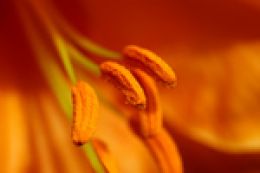 Anther
the pollen-bearing end of the male organ (stamen) of a flower; the anther usually protrudes from the center of the flower
Anther
the pollen-bearing end of the male organ (stamen) of a flower; the anther usually protrudes from the center of the flower

-
Bare Root Plant
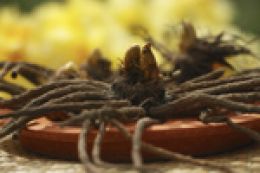 Bare Root Plant
a plant that is sold with the roots exposed, rather than already potted in soil
Bare Root Plant
a plant that is sold with the roots exposed, rather than already potted in soil

-
Basal Plate
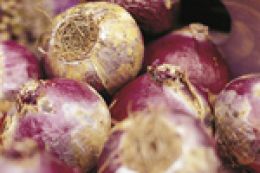 Basal Plate
the lower, usually round surface of a bulb from which the roots grow
Basal Plate
the lower, usually round surface of a bulb from which the roots grow

- Biennial Biennial a plant that completes it's lifecycle in two years (e.g. - sweet william, parsley)
- Bolting Bolting a plant that flowers and produces seeds too soon
-
Bracts
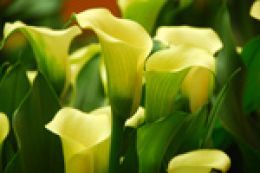 Bracts
on some plants, these are the colorful leaves that attract attention instead of a blossom (e.g. - poinsettias)
Bracts
on some plants, these are the colorful leaves that attract attention instead of a blossom (e.g. - poinsettias)

- Broadcast Broadcast to scatter seed and fertilizer
-
Bulblet
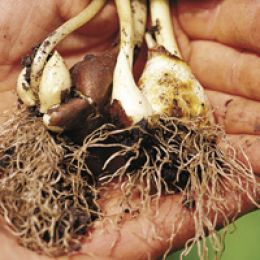 Bulblet
a small, offset bulb, usually produced on the underground stem of the parent bulb
Bulblet
a small, offset bulb, usually produced on the underground stem of the parent bulb

- Calyx Calyx refers collectively to all the sepals together that enclose and protect the flower in bud; typically found beneath the open flower
-
Corm
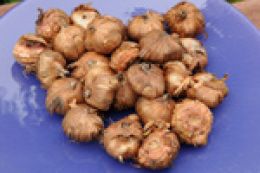 Corm
type of bulbs that is solid and hard in substance and usually rounded and slightly flattened (e.g. - crocus, gladiolus)
Corm
type of bulbs that is solid and hard in substance and usually rounded and slightly flattened (e.g. - crocus, gladiolus)

-
Corolla
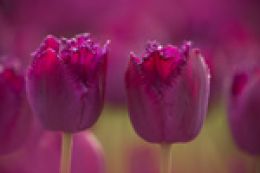 Corolla
a collective word for the union of all petals together that form part of the flower structure
Corolla
a collective word for the union of all petals together that form part of the flower structure

-
Corona
 Corona
an interior flower structure, found between the corolla (all petals together) and the stamens, that resembles a crown or, as it is called for daffodils, a cup
Corona
an interior flower structure, found between the corolla (all petals together) and the stamens, that resembles a crown or, as it is called for daffodils, a cup

-
Crown
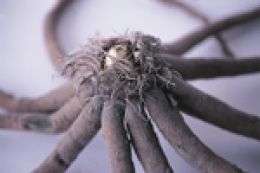 Crown
a plant's crown is the spot where it's roots and stem meet
Crown
a plant's crown is the spot where it's roots and stem meet

- Cultivar Cultivar an artificially created variety (through breeding or hybridization), like all of the different varieties of roses that exist today; the word comes from combining "cultivated variety"
-
Cup
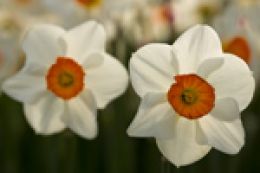 Cup
a part of a flower that exists between all the petals (corolla) and stamens of daffodils for instance; quite often the color of the cup is different from the petals; sometimes also called ‘corona’
Cup
a part of a flower that exists between all the petals (corolla) and stamens of daffodils for instance; quite often the color of the cup is different from the petals; sometimes also called ‘corona’

- Cutting Cutting a section of a stem that is cut off; it's lower leaves are removed, and it is partly buried in the soil so it will form roots
-
Deadhead
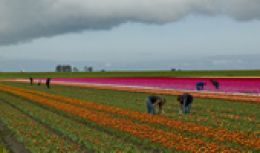 Deadhead
to increase the number of flowerbuds and extend the blooming time of an annual or perennial by snipping off the flowers after they fade but before they go to seed; the growers in Holland do this well to enhance the growth of the bulbs themselves (e.g. - impatiens, petunias)
Deadhead
to increase the number of flowerbuds and extend the blooming time of an annual or perennial by snipping off the flowers after they fade but before they go to seed; the growers in Holland do this well to enhance the growth of the bulbs themselves (e.g. - impatiens, petunias)

- Dibble Dibble a small tool used for transplanting or pricking out seedlings
- Disbud Disbud to remove flower buds from clusters so that the remaining flowers grow larger
-
Divide
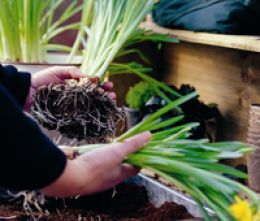 Divide
to separate overcrowded clumps of bulbs or plants into smaller, plantable pieces to stimulate new growth and more flowers
Divide
to separate overcrowded clumps of bulbs or plants into smaller, plantable pieces to stimulate new growth and more flowers

- Dormancy Dormancy the yearly cycle in a plant's life when growth slows and the plant rests (do not fertilize during this time)
-
Double Flower
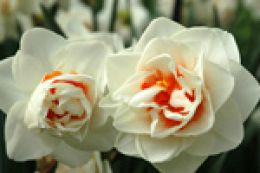 Double Flower
a flower with many overlapping petals which gives it a very full appearance
Double Flower
a flower with many overlapping petals which gives it a very full appearance

- Drainage Drainage the movement of water downward through the soil. If soil is saturated with water air is forced out and roots perish from lack of oxygen. Good drainage is essential for all bulbs
-
Drift
 Drift
a long, natural irregular free form planting (like a drift of daffodils that imitate the look of bulbs in the wild)
Drift
a long, natural irregular free form planting (like a drift of daffodils that imitate the look of bulbs in the wild)

-
Eye
 Eye
a not-yet-active and barely visible bud
Eye
a not-yet-active and barely visible bud

-
Filament
 Filament
the stalk of the male organ (stamen) of a flower
Filament
the stalk of the male organ (stamen) of a flower

- Flat Flat a shallow box used to start cuttings or seedlings
-
Foliage
 Foliage
a fancy term for leaves
Foliage
a fancy term for leaves

-
Forcing
 Forcing
the process of speeding up a plant's growth to maturity or bloom
Forcing
the process of speeding up a plant's growth to maturity or bloom

- Full Shade Full Shade refers to a location that receives no direct sunlight
- Full Sun Full Sun refers to a location that receives six or more hours of direct sunlight
- Genus Genus a group of plant/bulb species that are structurally related (e.g. - Tulipa / 'tulips')
- Hardening Off Hardening Off acclimating a plant to an outdoor climate after growing them indoors; should be done gradually and with protection from the sun
- Hardiness Hardiness the ability of a plant to withstand specific environmental conditions like low temperatures or frost without artificial protection
- Hardiness Zone Map Hardiness Zone Map gardeners need a way to compare their garden climates with the climate where a plant is known to grow well; that's why climate zone maps were created. Zone maps are tools that show where various permanent landscape plants can adapt
- Hardpan Hardpan the impervious layer of soil or clay that lies beneath the topsoil
- Hybrid Hybrid the result of a cross (breeding) of two parent plants (often of two different species)
-
Inflorescence
 Inflorescence
the flowering structure: the complete overall arrangement of flowers on a plant
Inflorescence
the flowering structure: the complete overall arrangement of flowers on a plant

-
Inter-planting
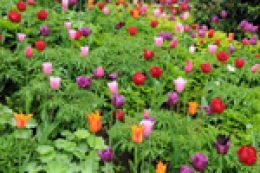 Inter-planting
mixing and matching different types of plants to create depth, height, structure, a certain color scheme and to ensure something different is in bloom almost all season long. For instance planting tulips scattered amongst your perennials
Inter-planting
mixing and matching different types of plants to create depth, height, structure, a certain color scheme and to ensure something different is in bloom almost all season long. For instance planting tulips scattered amongst your perennials

- Invasive Plants Invasive Plants such trees, shrubs, and vines can spread quickly; left unchecked, this growth can end up choking out all other desirable plantings
-
Involute
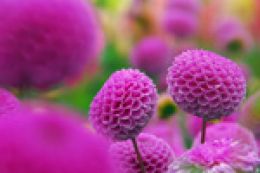 Involute
a flower petal that is turned inward. Sufficient involution will create a tubular petal which may be referred to as Fully involute or Quilled (e.g. - Ball-type dahlias)
Involute
a flower petal that is turned inward. Sufficient involution will create a tubular petal which may be referred to as Fully involute or Quilled (e.g. - Ball-type dahlias)

- Leaf Molding Leaf Molding decomposed leaves valuable for mulching and improving soil quality
- Lifting Lifting digging up a bulb from the ground gently
- Loam Loam a relatively equal mix of sand, silt, and clay that keeps a garden healthy; loam soil is high in organic matter and usually has good drainage
- Microclimate Microclimate variations of the climate within a given area (such as when it's raining at your house but the sun is shining across the street)
- Mulch Mulch depending on your budget, effectiveness of intended purpose, appearance, and availability a wide variety of materials can be used: compost, leaves, straw, bark nuggets, shredded wood, pine needles, crushed stones and even animal manure
- Mulching Mulching placing a layer of mulch across your flower beds with the multiple purpose of fertilizing , preventing erosion and maintaining a more balanced moisture level (less evaporation), improving soil quality
- N-P-K N-P-K you will find this term used in fertilizer formulas to indicate the ratios of certain elements; the letters stand for nitrogen, phosphorous, and potassium. How do you know what is beneficial for what? Just remember "Little Red Flower": L stands for leaves, R for roots and F for, well yes, flowers; nitrogen enhances the growth of the leaves, Phosphorous the roots and Potassium the flowers; NPK = LRF
- Naturalizing Naturalizing when bulbs and plants in the right environment (usually something close to their native habitat) multiply and return each year in randomly changing patterns, making it appear as if they grew naturally like wildflowers
- Offset Offset small bulb that is produced from a mature bulb. They can be separated and planted on their own. Larger offsets will bloom the first year after separation, smaller ones may take a year or two
- Percolate Percolate to filter through a porous substance like soil, gravel, or sand
- Perennial Perennial a plant is considered perennial if it lives for two or more seasons (e.g. - hostas, daffodils, daylilies)
-
Perianth
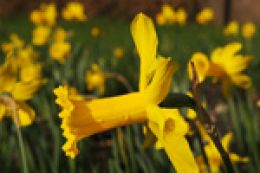 Perianth
the outer, non-sexual parts of a flower, including the petals or sepals both; used to attract pollinators such as bees
Perianth
the outer, non-sexual parts of a flower, including the petals or sepals both; used to attract pollinators such as bees

-
Petal
 Petal
the often brightly colored, individual leaves that surround the reproductive parts of a plant’s flower
Petal
the often brightly colored, individual leaves that surround the reproductive parts of a plant’s flower

- pH pH a chemistry term, the value of which indicates whether your soil is 'Acid' (pH value between 4.0 and 6.9) or 'Alkaline' (pH value between 7.1 and 9.0); the latter is common in chalky or lime soils which are best for many bulbs
- Pinching Pinching to encourage a fuller form or bigger blooms, pinch off (remove) growing tips or shoots of young plants or flower bulbs
-
Pistil
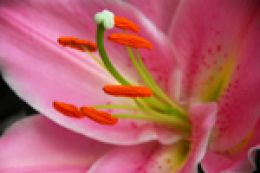 Pistil
the female part of the flower that accepts pollen. It is made up of ovary, style and stigma
Pistil
the female part of the flower that accepts pollen. It is made up of ovary, style and stigma

- Plant Habit Plant Habit the form a plant naturally takes as it grows, such as spreading or climbing
-
Reflexed
 Reflexed
a flower petal that is bent outward or backward (e.g. - tigridias, tiger lilies)
Reflexed
a flower petal that is bent outward or backward (e.g. - tigridias, tiger lilies)

-
Rhizome
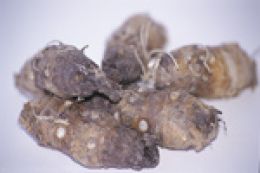 Rhizome
a type of bulb with solid tissue and usually elongated in shape (e.g. - cannas, callas)
Rhizome
a type of bulb with solid tissue and usually elongated in shape (e.g. - cannas, callas)

-
Root Ball
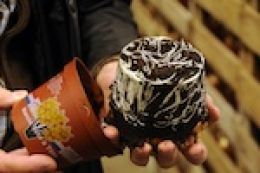 Root Ball
the network of roots along with the attached soil, of any given plant
Root Ball
the network of roots along with the attached soil, of any given plant

-
Sepal
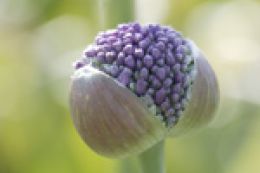 Sepal
individual leaf-like structures, usually green, that enclose the flower in bud stage
Sepal
individual leaf-like structures, usually green, that enclose the flower in bud stage

-
Spadix
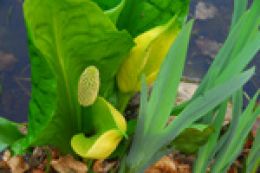 Spadix
an inflorescence of many tiny flowers clustered on a central stalk (e.g. - Calla lilies, Jack-in-the-pulpit)
Spadix
an inflorescence of many tiny flowers clustered on a central stalk (e.g. - Calla lilies, Jack-in-the-pulpit)

-
Spathe
 Spathe
also called a ‘bract’ at times: a showy, modified leaf that has developed in what almost looks like a flower and encloses a spadix (e.g. - Calla lilies, caladiums, Jack-in-the-pulpit)
Spathe
also called a ‘bract’ at times: a showy, modified leaf that has developed in what almost looks like a flower and encloses a spadix (e.g. - Calla lilies, caladiums, Jack-in-the-pulpit)

- Species Species a group of plants/bulbs having similar distinctive characteristics; a species is a subordinate member of a genus (e.g. - 'Darwin hybrid')
- Sport Sport a plant/bulb that is distinctly different from its parents, resulting from a natural mutation
- Staking Staking providing support to a taller-growing plant with a stick, rod or ring and some wire, twist ties, or rope
-
Stamen
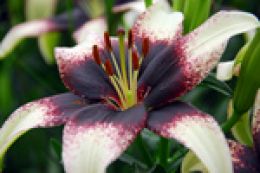 Stamen
the male organ of the flower, which produces and bears pollen at the end of a stalk (filament)
Stamen
the male organ of the flower, which produces and bears pollen at the end of a stalk (filament)

-
Stigma
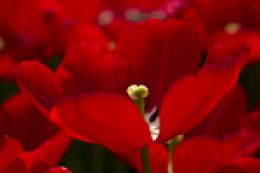 Stigma
the top of the female organ (pistil) of a flower; when sticky, it receives pollen from the anther
Stigma
the top of the female organ (pistil) of a flower; when sticky, it receives pollen from the anther

- Strain Strain a group of hybrid plants producing offspring that are more or less true to their parents
-
Style
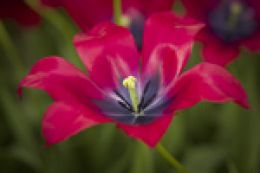 Style
a part of the female organ (pistil) of a flower; it is the elongated section upon which the stigma rests
Style
a part of the female organ (pistil) of a flower; it is the elongated section upon which the stigma rests

- Tepals Tepals so called when the petals and sepals of a flower look similar
- Top-dress Top-dress to evenly spread fertilizers or other soil amendments (mulch, compost) over the surface of the soil
-
Transplanting
 Transplanting
digging up a plant and moving it to another location
Transplanting
digging up a plant and moving it to another location

-
(True) Bulbs
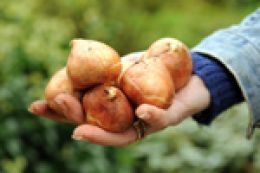 (True) Bulbs
think of them as very big seeds: an underground stem with a growing point surrounded by fleshy scales which store their food (e.g. - tulips, snowdrops, onions)
(True) Bulbs
think of them as very big seeds: an underground stem with a growing point surrounded by fleshy scales which store their food (e.g. - tulips, snowdrops, onions)

-
Tuber
 Tuber
a type of bulb which varies widely in shape and size (e.g. - begonias, dahlias)
Tuber
a type of bulb which varies widely in shape and size (e.g. - begonias, dahlias)

-
Umbel
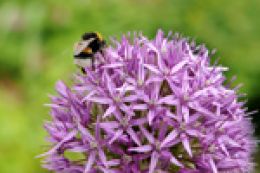 Umbel
a ball-like flower cluster with individual flower stems sprouting from a common point at the top of the stem
Umbel
a ball-like flower cluster with individual flower stems sprouting from a common point at the top of the stem

-
Underplanting
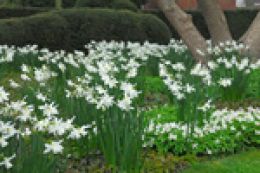 Underplanting
deliberately creating or introducing a canopy or garden layers by planting taller-growing species alongside shorter-growing species, particularly with bulbs near or under trees and shrubs
Underplanting
deliberately creating or introducing a canopy or garden layers by planting taller-growing species alongside shorter-growing species, particularly with bulbs near or under trees and shrubs

-
Variegated
 Variegated
foliage that is striped or marked with a color other than the basic green leaf
Variegated
foliage that is striped or marked with a color other than the basic green leaf

- Variety Variety variations in species that occur in nature or that have been cultivated by man (e.g. - 'Pink Impression')
- Wet feet Wet feet a garden location with poor drainage that leaves plants in constant moisture, which may end up suffocating and rotting their roots



